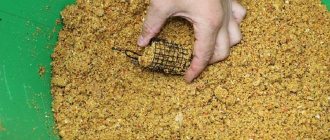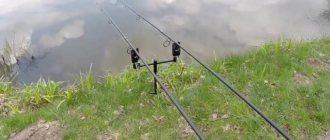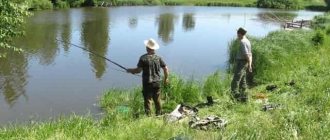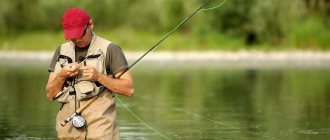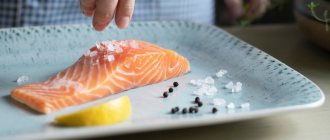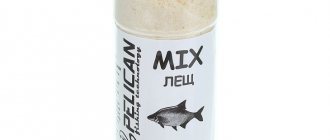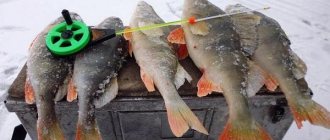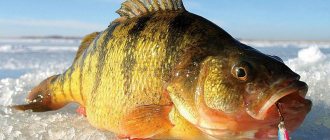Autumn is a great time for fishing for predatory fish. During this period, her activity increases sharply, and she is in constant search of food. Perch is no exception. This striped predator, preparing for the winter, increasingly comes out of the depths and actively hunts.
September and October are considered the most suitable months for perch hunting. At this time, fishermen rush to reservoirs in the hope of satisfying their hunting passion before the long winter. And the culinary properties of the striped predator at this time are simply excellent. Having gained fat over the summer, it is much tastier than in the spring.
Perch fishing in September
In September, the perch has not yet departed from the summer regime. It is inactive, prefers to be away from the shore and hunts without much enthusiasm. If the weather is hot, you can only catch it in the morning and evening.
During the day, the perch moves further from the shore into cooler water. During this period you can catch him at:
- float rod;
- feeder tackle;
- spinning;
- summer jig;
- donku;
- an elastic band.
Gear for perch fishing is selected based on fishing conditions and the characteristics of the reservoir. Worms, bloodworms, live bait, as well as various artificial baits for spinning rods are used as bait. By and large, perch fishing in September is not much different from spring or summer fishing. With the first cold snap, its behavior changes dramatically, but catching a striped predator during this period will not be difficult even for a novice fisherman.
Tips for beginner fishermen
Binoculars will help you find perch cauldrons in a vast area of water. Spinners achieve the best results when fishing using equipment with two or three baits. Already in October, when the water temperature drops, the perch stops chasing fry near the surface.
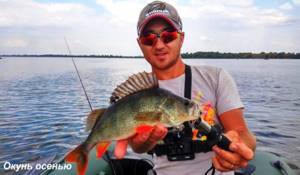
Before going to the pond, you should check the fisherman’s lunar calendar for the week. The phases of the moon influence the behavior of perch throughout the year, and the activity of the striped predator depends on them. If, after looking at the calendar, it turns out that the coming days are unfavorable for perch fishing, you can refuse to go fishing.
In autumn, spinning anglers achieve the best results in hunting for striped predators. Spinning fishing at this time brings many trophies. Active fishing, which involves constantly moving around a reservoir and exploring the water area with the help of quick baits, will always allow you to always have a catch in the fall.
Perch fishing in October
The cold activates the perch and pushes it to search for food. Increasingly, it is located near the shore, feeding on fry, as well as insects that have fallen into the water along with autumn leaves. Flocks of small “sailors” chase small change in the coastal zone around the clock. The “boiling water” created by the frightened fry will indicate the location of the predator.

You should not look for a large humpback whale near the shore. He rarely leaves his deep abode. Catching large perch involves luring it out of holes, snags, deep pools and creeks remote from the coastline using live bait, spinners or wobblers. You can also use feeder, float or donkey tackle, but their effectiveness, in comparison with spinning, will be much less. The whole point is that a stationary bait will not be able to attract a humpback salmon the way a spinner will do.
Fishing for perch in October will undoubtedly bring a good catch and pleasure from fishing if you choose the right tackle and bait.
What is the best way to catch perch in October?
The most effective devices for autumn hunting for both sailor and humpback salmon are:
- spinning;
- summer jig;
- float rod.
Catching perch in the fall is most often carried out not from the bottom, as in spring or summer, but from the surface of the water or in its thickness. This is also due to the seasonal characteristics of the predator’s behavior. During this period, he prefers to hunt precisely in such horizons. Therefore, the listed gear must have settings designed for the average depth of the fishing spot.
How to properly feed perch?
If you use bait such as worms or maggots, then it is more convenient to use it in a feeder. To do this, small worms are placed in a small box with holes, which after a while begin to gradually emerge from them, thus attracting prey to the selected place. You cannot do without a feeder if there is a large current at the fishing site.
Dry mixtures are also used to attract predatory perch to the desired location . They are intended for small fish, which, in turn, become excellent bait for predators.
To catch perch above the bottom, bait thrown into the water should crumble in it, forming a cloud.
To constantly maintain it and keep the predator in place, it is necessary to regularly throw in small portions.
Spinning equipment for perch
For spin fishing for small perch you will need:
- light class spinning rod (up to 22 g) up to 3.5 m long;
- spinning reel with spool size 1000-1500;
- monofilament line with a thickness of 0.25 mm or braided line with a cross-section of 0.2 mm;
- fishing line for a leash 0.2 mm thick;
- carabiner for attaching bait;
- bait in the form of a spoon, spinner, jig head, vibrotail or small wobbler.
It is desirable that the rod blank has an elastic tip. This will make it possible to make a more accurate cast and increase the efficiency of hooking. The reel can also be used without a friction brake. For small specimens it is not needed. A steel leash in the rig is also not needed - the perch will not bite the fishing line.
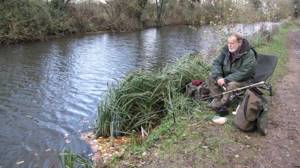
If you plan to catch humpback salmon, the tackle needs to be strengthened. The thickness of the fishing line should be increased by 0.1 mm, and it is better to take a reel with a friction clutch.
In order to properly assemble the tackle, you first need to secure the reel to the rod handle. For this purpose, it has a reel seat. If the design of the form does not provide for it, the coil can be secured using electrical tape or adhesive tape. The line is threaded through guide rings from the tip of the rod and secured to the spool with a simple loop. Its length must be at least 100 m. The line is wound onto the reel by rotating its handle. Next, we tie a leash to it using the “loop-to-loop” method, to which the bait will cling through a carabiner.
Selection of baits and equipment for catching perch in autumn
In this aspect, it is necessary to start from the type of bait; they are quite diverse and have a number of requirements for the spinning kit:
1. Rotating spinners.
Certainly effective and very popular for catching perch. Fishing in the “cast and spin the reel at medium speed” style. Quite simple and understandable for beginner fishermen. The spinning rod is selected in the test range from 02 to 15 grams with a length from 210 to 270 cm. The action of the rod should be medium, not rigid. The choice of length depends on the expected fishing distance. The further you go, the longer the spinning rod should be. The spinning reel size is from 1000 to 2000 according to the Shimano classification. It is possible to use both monofilament lines and braided cords with a thin diameter.
2. Small vibrations.
The nature of the wiring of these baits involves a combination of pauses and uniform reeling. A spinning rod is selected with a weight from 03 to 15 grams, with a slow action. The reel is selected in sizes from 1000 to 2000 according to the Shimano classification. It is recommended to use braided cords with a diameter of up to 0.1 mm.
3. Small wobblers.
As a rule, these are baits measuring up to 90 mm and weighing up to 7 grams. When fishing with a jerk retrieve, the spinning rod must have a fast action with a test range from 2 to 10 grams. If the wobblers are of the “crank” type, then the rigidity of the spinning rod’s form fades into the background. In skillful hands, a wobbler literally becomes a “perch killer”; if there is a school, you can make a hundred casts and get a hundred bites. The height of such rods should not exceed 228 cm, the reel is recommended in sizes from 1500 to 2500. The fishing line, only braided in a thin section, due to its structure and lack of extensibility, it conveys absolutely all the information to the angler about the bait.
4. Micro jig baits.
Very popular among fishermen due to their phenomenal catchability. Allows you to catch perch of absolutely any size. The test of a spinning rod depends directly on the weight of the lead weight. There are several most popular tests, from 0 to 5 grams, from 2 to 7 grams. The structure of the rod for microjig fishing has the following characteristics: a fairly hard butt and a soft tip, which is responsible for the animation of the silicone bait (tosses, movements) and visualization of the bite. It is proposed to use ultra-thin lines to minimize resistance when casting and retrieving in the water column. Recommended silicone baits: small-sized worms and twisters, up to 1.5 inches, imitation crustaceans, imitation natural food items (artificial bloodworms, larvae), silicone cuts. The reel is selected according to a similar algorithm, tied to the weight of the rod and proportionality, but the main condition is the ability to lay thin fishing lines evenly, which not all brands are capable of.
5. Vibes (rattlins)
. They show excellent results when catching actively feeding predators in the fall. Wiring can be varied, from “stop and go” to active tosses with a rod. The rod should be hard, from 210 to 240 cm long, with a test weight of 07 to 15 grams.
6. It’s worth highlighting light jigs
. Why are they good for catching perch? They fly quite far, the aerodynamic shape is responsible for this. They are responsive to different types of animation, from tossing to uniform winding, and they flow attractively when paused. If you equip the jig hook with an assist (single hook on a line), the number of trips will sharply decrease. A spinning rod for such fishing should not be too rigid, otherwise it will not be possible to achieve the maximum long-distance casting. Lines, only braided ones, will allow you to cast far and feel everything.
Choosing a spinning bait
Spinning perch fishing in the fall can only be successful if you choose the right bait. You should not use large spoons. This will not increase the size of the catch. In the fall, perch prefers to hunt small prey, so a small twister or small oscillating spoon is ideal. The predator also reacts well to a silicone vibrotail. It is better if it is of a bright natural color, but in no case poisonous. Such colors are certainly not intended for this type of fishing, such as autumn perch fishing. Lures for this predator should resemble as much as possible a fry or an insect.
Casting and basic methods of spinning fishing for perch
Casting the tackle is carried out by sharply swinging the rod forward with the preliminary opening of the locking bracket. It is advisable for the bait to fall a little further than the intended location. This will allow you to spend it as close as possible to a flock of predators.
In order for the most effective fishing for perch in October using a spinning rod, it is important to choose the right type of fishing. If you were able to visually determine the location of the school, you need to cast, wait until the bait sinks to the bottom, and begin a smooth, even retrieve. There is no need to make any sudden movements or pull-ups. This may spook the perch.
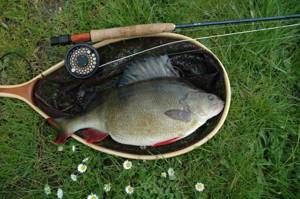
If a predator is not visible, this does not mean that it is not there. Most likely, he is waiting for his victim in ambush. To lure it out, you should cast it to the intended place and, using intermittent sharp retrieval, try to irritate it and force it to attack the bait. The spoon or wobbler should not go along the bottom; it is better to keep the bait in the middle water horizon.
Techniques for catching perch using a spinning rod
When catching perch with spinning tackle, it is important to correctly perform such basic elements of fishing techniques as casting, retrieving, hooking and retrieving.
Casting
When catching perch, use light-weight lures, cast at short and medium distances using vertical or lateral casting methods. The latter is relevant in a limited space of banks overgrown with bushes and trees.
Wiring
When fishing for October perch, depending on the activity of the predator, the following fishing techniques are used:
- Uniform - winding a cord or fishing line with a bait thrown into the water by uniformly rotating the reel handle
- Stepped - after casting, the bait is allowed to sink to the bottom, then it is raised by winding the line with a reel, performing 3-4 turns of the handle, making a pause, during which the bait smoothly sinks to the bottom, and rewinding again. With this type of wiring, the bait moves in steps, either rising from the bottom into the water column, then falling or gliding back to the bottom soil.
- Jerk - used when fishing with floating and sinking wobblers. Its essence is to perform sharp and short jerks with the tip of the blank while guiding the bait through the water column.
- “Stop and go” - used when fishing with wobblers with neutral buoyancy “hovering” in the water column and consists of reelings (3-4 turns of the reel handle) and short pauses lasting 1-3 seconds, during which the bait freezes in a certain layer of water and is usually attacked by perch.
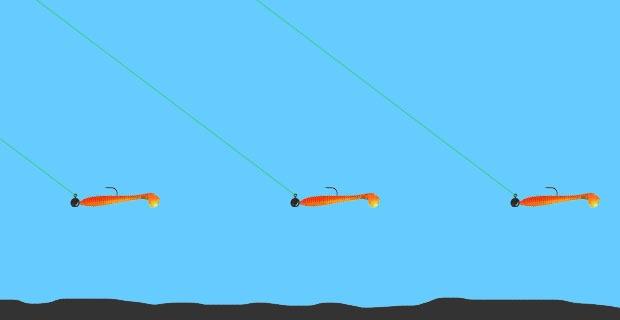
Uniform wiring
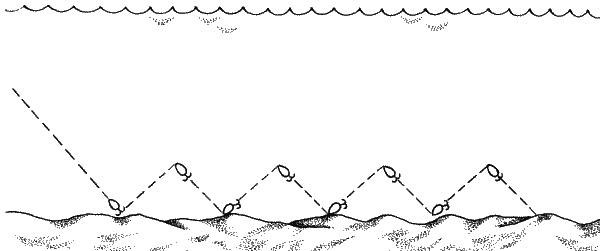
Hooking and landing
The bite of a perch on a spinning tackle - a short single or several strong frequent strikes on the bait - is quite sensitive and, most often, is not only clearly visible only at the tip of the rod blank, but is also felt by the hand holding the spinning rod (“gives it to the hand”). Hooking should be done with a sharp wrist movement of the hand.
When fishing for especially large specimens, the rod should be held at an angle of no more than 450, alternating winding the line with a reel and pulling the hooked fish to the shore with a blank. This fishing strategy will allow you to evenly “load” both the reel and the form itself, avoiding their breakage and the removal of hooked fish.
Video on catching large perch using a spinning rod in October and November
Summer jig for perch
The jig is mostly a winter tackle, but it is also successfully used at other times of the year. This is a small lead or tungsten figurine resembling an insect, into which a hook is sealed. Some models of jigs are painted in bright, fish-attracting colors, which allows them to be used for fishing without bait. But in our case, it is better to use the most ordinary lead pellet with a hook.
Catching perch with a jig in the fall involves using a rod 3-4 m long. Since fishing is carried out from the shore, this size will be quite enough to successfully fish coastal thickets and snags.
Finding perch in a pond
The ability to find fish in a body of water is a key condition for the success of autumn perch fishing with a spinning rod. As in all seasons, the best bite can be expected near bottom relief anomalies:
- pit;
- brow;
- underwater hills - navels.
When fishing from a boat on an unfamiliar body of water, you can quickly find such points using an echo sounder. If autumn fishing takes place from the shore, this requires jigging baits in the area of interest, identifying bottom anomalies by the nature of the movement of the equipment. Another option is to use a wireless echo sounder, which is cast from the shore using a spinning rod.
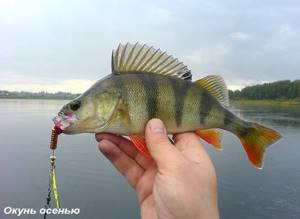
Snags are also promising places for fishing. If they are located at depth, the chances of catching a large perch here are maximum. At the beginning of autumn, the predator also pecks at the borders of grass thickets and open water.
To find out how to properly catch perch using a spinning rod on an unfamiliar body of water and quickly achieve success, you need to ask advice from experienced fishermen who are familiar with the water area and have managed to study the habits and habitats of the predator. In this case, you won’t have to waste time choosing the key to the fish yourself.
In September, schools of perch chasing fry near the surface are clearly visible from afar. In October, it is better to start searching for perch from areas located away from the shore, fishing with jigs, spoons or wobblers. In November, you need to first explore the deepest parts of the reservoir.
On reservoirs that do not freeze all year round, fishing for perch with a spinning rod continues in winter. When choosing a fishing spot for winter spinning, you need to adhere to the same rules as when fishing in October.
Choosing a fishing spot
To make fishing with a spinning rod comfortable and effective, you need to find points on the reservoir where perch hunt, where it is convenient to cast bait and make retrieves. When fishing from a boat, the angler has access to the entire water area - he has the opportunity to fish both under the shore, making movements from the shallows to the middle of the reservoir, and at the depths where trophy specimens are kept.
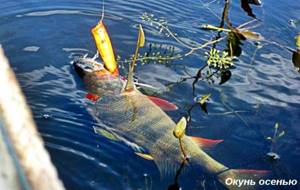
If there is no watercraft available, the task becomes more complicated. In early autumn, perch can be caught using spinning rods almost everywhere. But in the second half of autumn, you can count on good catches without having a boat only in those places where deep areas are located in close proximity to the shore, and baits reach them.
Installation of a summer jig for perch
The rod can be anything, even wooden. The only requirement for it is a hard top. A piece of aluminum wire 5-7 cm long is attached to it with electrical tape or adhesive tape. A nipple tube of the same size is placed halfway on its end, having first pulled a fishing line through it. The nipple forms a kind of nod, which will signal a bite.
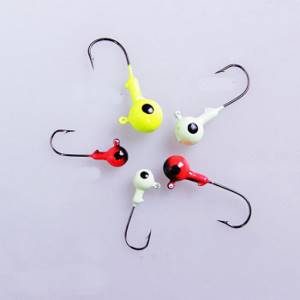
The fishing line will need no more than 3 m, since fishing will be carried out almost vertically. You can tie it to the tip of the rod in any convenient way. The jig is attached to a leash or even to the main line - at the discretion of the angler. The method of tying it will not play a special role in the outcome of the fishing.
Bait and the principle of jig fishing
As bait you can use pieces of red rubber, thread of the same color, but the best thing, of course, is bloodworms - the favorite food of perch. With such bait the catch is guaranteed.
The method of fishing with a jig is quite simple. The cast is made at a distance equal to the length of the rod. The fishing rod itself can be installed on a holder or, during active biting, in the hands of the fisherman. To attract the attention of a predator, you can play with the tackle, pulling it up and down with a small amplitude.
Float tackle for perch in autumn
Catching perch in October can also be done with a regular float rod. This classic item is easy to rig for predator fishing.
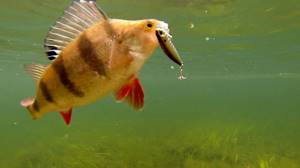
For this you will need:
- rod 3.5-5 m long with fast or slow action;
- simple spinning reel size 1500-2000;
- main line with a cross-section of 0.25-0.3 mm, length 50-100 m;
- fishing line for a leash with a thickness of 0.15-0.2 mm;
- float (better for sliding equipment);
- weight (weight is selected under the float);
- hook (preferably single, No. 4-7).
How to catch perch in the fall
Catching perch with a spinning rod in the fall, as well as using live bait and classic float gear, is one of the most popular methods. The methods presented are used to fish from shorelines and boats. Compared to other types of fish, striped predators are not so timid, and sometimes even the excessive fuss of a fisherman can cause a curious and voracious school to approach. When perch hunting there is no particular need for camouflage.
Important! The success of fishing depends on the feeding area of the predator found in the reservoir.
When planning a strategy for catching perch, you must initially understand that the fishing session will take place in a dynamic mode with frequent changes of hunting points.
Fishing in autumn with a float rod
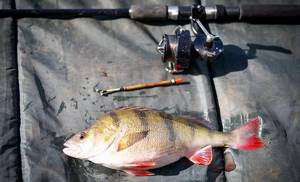
A classic float rod is used to fish using plant or small animal baits. In perch fishing, match, Bolognese and fly tackle can be used, here it all depends on the distance at which the bait is supplied. It is more practical to use nylon fishing lines with a thickness of 0.2 mm. Floats are taken in the shape of a stick or spindle-shaped, with a non-massive body, a long, up to 20 cm, keel and the same antenna. The leashes are used 0.02 mm thinner than the base and are equipped with a hook with an elongated shank, for more convenient removal of almost always a deep-throated instrument.
Using a float tackle, they catch points near the thickets and move the bait over promising areas of the bottom. Live bait tackle for perch is equipped with an olive-shaped foam float with a short antenna and a mass capable of balancing and holding live bait in a certain water horizon. The loads are placed stationary, from lead shot, using the garland principle. The predator's bites are sharp, without preliminary testing, with the float moving to the bottom. A sinking float indicates the moment of careful hooking.
How to catch perch in the fall using a spinning rod
For spinning hunting, ultralight or light tackle with a length of 1.5 to 3 meters is used. Spinning fishing for autumn perch is carried out with small and medium baits, reaching a mass of no more than 16 grams even at significant depths. For the base of the cord, braids with a diameter of 0.15 mm are used, which are wound onto lightweight, inertia-free reels marked 1000–1500. Perches are worthy fighters, especially if there is a 1-1.5 kg humpback salmon on the hook, and the presence of a finely tuned clutch makes the fishing process much easier.
We catch perch in the fall using spinning rods, both with spaced and combined equipment, without the use of reinforced and especially metal leashes. The bite of a fish is felt as a pronounced poke followed by a slight trembling; after self-hooking, the perch actively shakes its head, trying to free itself from the bait hook stuck in its mouth.
Important! When fishing, do not force the winding of the cord, otherwise the fish’s delicate lip will be torn by the hook, thereby adding only an annoying derailment to the score.
Small specimens are lifted directly into the boat with the rod blank or pulled ashore. Respectable humpback whales are taken into the landing net.
Posting options
The rotation of a rotating or oscillating spoon is carried out at the bottom at low speeds of the reel, creating the image of an object sneaking and sometimes scratching along the bottom. When the fish is inactive, pauses are allowed with the fishing tool falling to the ground. When jigging, silicone baits are used with a short step, tapping the bottom with a weight. When using drop-shot, queen or Texas rigging techniques, rigs are carried out at reduced speeds, responding to every poke into the bait with a hook.
In the absence of bites, change the levels of the nozzles without changing the trajectory of the wiring itself and the fishing location. Hunting using minnow wobblers is carried out in twitching mode on a short dotted line with pauses from 3 to 5 seconds, using suspended baits hanging in the thickness. The cranks are guided in a uniform manner, allowing the bait to reach individual operating parameters. The direction of the wiring can be either against the current or in the opposite direction, otherwise upstream.
Installation of a float rod for a perch
The tackle is mounted on the same principle as a spinning rod: the fishing line is passed through the rings and wound onto the spool of the reel. In total it is needed up to 100 m.
A sliding float with a single-point fastening and an upper limiter in the form of a rubber bead is attached to the main line. The weight of the load is determined by a preliminary test in still water. It should not sink the float below the antenna.
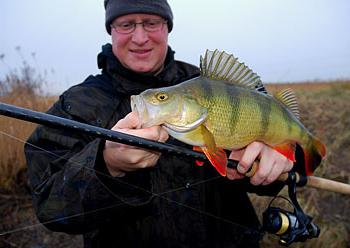
The leash is knitted using the “loop-to-loop” method, and its end is equipped with a hook. It can be single, double or triple. If you plan to catch a small perch, it is better to use a regular hook. It is advisable to use doubles or tees for fishing for trophy specimens.
Lures for float tackle
For bait, you can use bloodworms or maggots. It’s great if you manage to catch a fry and bait it on a hook. It is better to insert it behind the nostrils, one or both lips.
Catching perch with a fishing rod and float rig is carried out in the usual way. A cast is made, the tackle is pulled up until the line remains taut. The rod is installed on the holder. The tackle is controlled visually. If the float indicates a bite, a hook is made and the catch is landed.
